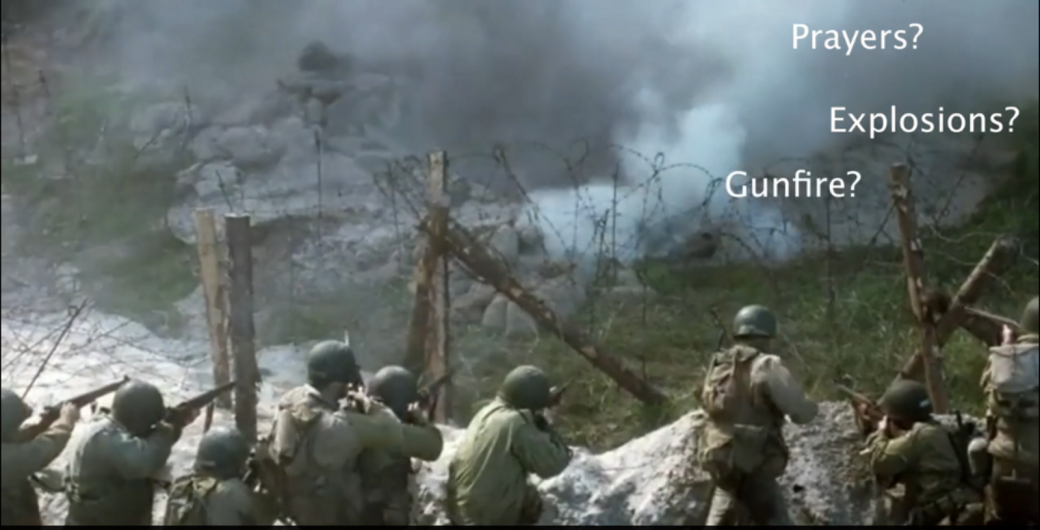Black Hawk Down, Saving Private Ryan, and the Sounds of War
This video essay examines the war films Black Hawk Down (Ridley Scott)1 and Saving Private Ryan (Steven Spielberg)2 in order to showcase how the war movie genre conveys concepts of conflict and perceived authenticity. It highlights different approaches to soundscapes in war scenes and connects them to established techniques which aim to engage the viewer in the conflict on screen.
Music in the war movie genre often has a clear narrative meaning, telling the audience about the cruelty of war and enhancing the importance of the heroes that have fought in it. For instance, while the graphic violence in Saving Private Ryan is frequently used to educate viewers about the horrors of war and the sacrifices of American soldiers, Black Hawk Down is more concerned with heroic fights resulting from the repercussions of American interventions and failed missions. Both movies paint a bleak picture of war in general, but through their sounds and music, they still portray their protagonists as the good guys, whose story is dramatically and emotionally loaded.
This correlates with the supposed authenticity of war movies. Since many of them are based on true stories and historical events, audiences expect an authentic portrayal of warfare, both on a material and a personal level. Beate Schirrmacher and Nafiseh Mousavi define these two qualities of authenticity as either referring to «a truthful connection to the past via historical objects, rituals, and traditions», or «human behavior that truthfully or sincerely expresses the inner states».3 Regarding Black Hawk Down, the US military invested an extensive amount of personnel and material in order to stay true to its original source.4 The sounds of the movie can help immerse the audience in this authentic performance on screen as well as intensify the viewing experience.5 With almost no downtime, the movie continues to bombard the viewer with verbal and physical confrontations between the supposedly evil, the desperate, and the saviors. Underscored by almost continuous, beat-driven music, the narrative continues to push forward and disorients the sensory overloaded audience. Nevertheless, the real chaos, unpredictability, and terror of a battlefield will (and probably should) never be offered in an authentic manner to the movie goers. There will always be a barrier which lets the audience experience war movies in a safe environment in which didactic strategies can be applied.
The scenes of this video essay were arranged to provide a short overview of how the war movie genre operates. For instance, by showcasing that through sounds, audiences watching Saving Private Ryan are given an instant sense of the space the soldiers operate in and the uneasy feeling one should experience when witnessing their sacrifices. Without any sound, battle scenes may seem less desperate, the emotional less affective, but they can also be immensely powerful. Paul Théberge calls this «diegetic silence», in which «selected parts of the soundtrack … are silenced … whereas other parts, such as music, continue to sound or are given special prominence».6 This play with sounds demonstrates that the pure absence of sound can already have such a significant impact, because the genre of war movies usually uses it to tell its stories.
While sound and music can never tell the whole story, they drastically enhance the viewing experience. Saving Private Ryan is musically framed through scenes at the Normandy American Cemetery and Memorial in France. Similar to its beginning, the film concludes with a six-minute piece of orchestra called «Hymn to the Fallen» leading to the end titles, which, as Todd Decker explains, does not only applaud the composer John Williams and the chorus, but also «veterans, soldiers, and the sacred idea of the nation»,7 leaving the audience with more than just the music, more than the movie itself. The emotional beginning and the patriotic outcome «force the audience to reflect, thereby opening a cinematic space where soldiers and veterans as embodiments of the nation are shown to be worthy of a memorializing moment’s pause».8 This «reflective music» is one of the most effective genre strategies which honors the individual war heroes while inviting the audience to join the moral support of US military members, and consequently the nation as a whole.9 Sound and music are thus not only helpful tools to accompany the images on screen, but they speak their own language and have a significant impact on the war movie genre and its audiences.
This video essay was first shown as part of the panel «Sounding the Video Essay: On Sound and Music in Videographic Scholarship», organized by Evelyn Kreutzer (Lugano) and Kathleen Loock (Hannover) at the 70th Annual Meeting of the GAAS on «American Soundscapes» at Oldenburg University in May 2024.
- 1
Black Hawk Down, Ridley Scott, USA, 2002.
- 2
Saving Private Ryan, Steven Spielberg, USA, 1998.
- 3
Beate Schirrmacher and Nafiseh Mousavi: Introduction: The Dynamics of Truthfulness and Media, in: Beate Schirrmacher and Nafiseh Mousavi (ed.): Truth Claims Across Media, Cham 2024, 13.
- 4
Laura Miller: Pentagon Helps Out With Black Hawk Down, PR Watch, Center for Media and Democracy, 21.1.2002, https://www.prwatch.org/spin/2002/01/989/pentagon-helps-out-black-hawk-down. (30.8.2024).
- 5
Todd Decker: Hymns for the Fallen: Combat Movie Music and Sound After Vietnam, Berkeley 2017, 20.
- 6
Paul Théberge: Almost Silent: The Interplay of Sound and Silence in Contemporary Cinema and Television, in: Jay Beck and Tony Grajeda (ed.): Lowering the Boom: Critical Studies in Film Sound, Urbana-Champaign 2008, 54.
- 7
Todd Decker: Hymns for the Fallen, 4.
- 8
Ibid., 14.
- 9
Ibid.
Bevorzugte Zitationsweise
Die Open-Access-Veröffentlichung erfolgt unter der Creative Commons-Lizenz CC BY-SA 4.0 DE.
